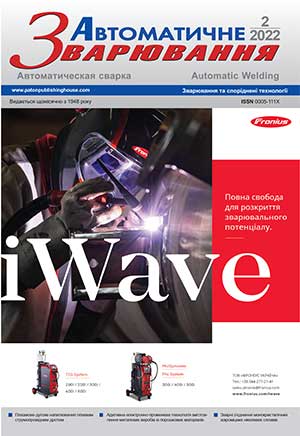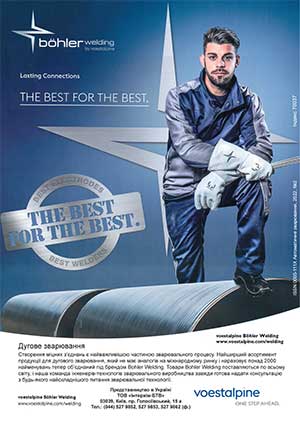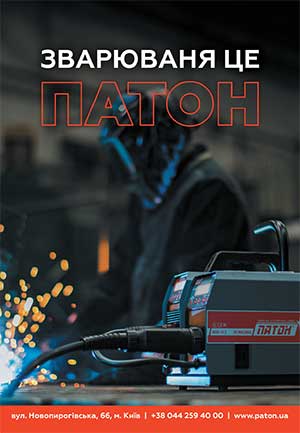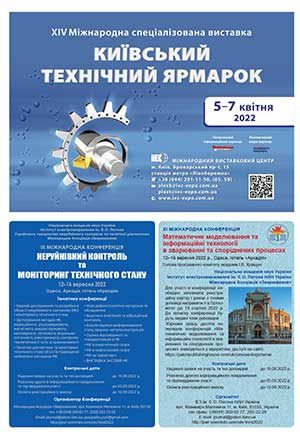| 2022 №02 (08) |
DOI of Article 10.37434/as2022.02.01 |
2022 №02 (02) |
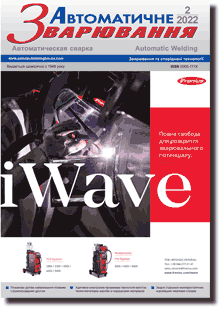
"Avtomatychne Zvaryuvannya" (Automatic Welding), #2, 2022, pp. 3-10
Influence of accompanying compressing air flow on the coating structure and properties in plasma-arc spraying by consumable current-conducting wire
V.M. Korzhyk1, V.Yu. Khaskin1, M.Yu. Kharlamov1, Yao Yuhui2, O.I. Demianov1, D.V. Stroganov1, V.O. Shcheretskiy1
1E.O. Paton Electric Welding Institute of the NAS of Ukraine. 11 Kazymyr Malevych Str., 03150, Kyiv, Ukraine. E-mail: office@paton.kiev.ua
2Shenzhen Hanzhizi Technology Co., Ltd. 6th Floor, Building B, Bantian International Center, 5 Huancheng South Road, Longgang District, Shenzhen, Guangdong, (China), E-mail: 514929948@qq.com
The paper is devoted to studying the technological features of plasma-arc spraying by consumable current-conducting wire-anode. The relevance of applying such a process is related to the possibility of spraying directly by atomization of wires without the need to make powders from them. Experimental verification of the results of mathematical prediction of the influence of annular protective flow of compressed air, accompanying the particle-loaded plasma jet, on the results of plasma-arc spraying by compact wire anodes was performed. The key role of increasing this flow rate above 20 m3/h for improvement of the spay-deposited coating formation and quality was established. In spraying of coatings from compact wires porosity decreased with increase of the values of flow rates of accompanying air flow G2, and achievement of this parameter values within 0.5…2.5 %. Conducted experiments allow producing porefree coatings in spraying with wires from М2 copper, Kh20N80 nichrome, NP1 nickel, AMg63 aluminium-magnesium alloy. Studying these experimental results showed that at increase of the rate of accompanying protective air flow G2 from 0 to 40 m3/h, the loss of alloying elements (С, Mn) during spraying by steels wires of 65G and 70 grades decreases by 30…40 % on average. Increase of the parameter of rate G2 of the air flow accompanying the particle-loaded plasma jet influences improvement of the coating adhesion strength and wear resistance. So, at G2 = 20…40 m3/h the adhesion strength at tearing off of coatings from steel 70 along the normal reaches 60…70 MPa, and that of coatings from М2 copper is 40…55 MPa. Wear resistance of coatings under the conditions of boundary friction and resistance at cavitation wear increases at G2 increase from 0 to 40 m3/h, which is manifested in reduction of such wear from 1.35 to 0.32 mg/min. 13 Ref., 9 Fig.
Keywords: plasma-arc spraying, compact wires-anodes, accompanying flow, material utilization factor, coating adhesion strength, wear resistance
Received: 10.12.2021
References
1. Babiak, Z., Wenz, T., Engl, L. (2006) Fundamentals of Thermal Spraying, Flame and Arc Spraying. Modern Surface Technology, CHAPTER 8, 119-136. https://doi.org/10.1002/3527608818.ch82. Kawaguchi, Y., Miyazaki, F., Yamasaki, M. et al. (2017). Coating Qualities Deposited Using Three Different Thermal Spray Technologies in Relation with Temperatures and Velocities of Spray Droplets. Coatings, 7, 27, 1-10. https://doi.org/10.3390/coatings7020027
3. Kharlamov, M.Yu., Krivtsun, I.V., Korzhik, V.N. et al. (2007) Mathematical model of arc plasma generated by plasmatron with anode wire. The Paton Welding J., 12, 9-14.
4. Kharlamov, M.Yu., Krivtsun, I.V., Korzhik, V.N. et al. (2008) Effect of the type of concurrent gas flow on characteristics of the arc plasma generated by plasmatron with anode wire. The Paton Welding J., 6, 14-18.
5. Ab, O. (2015) Atmospheric plasma spray process and associated spraying jet. International Conference on Thermal spraying, 77, 012008, 35-42.
6. Korzhik, V.N., Korob, M.F. (2012) Mechanized line Plazer 30PL-W for plasma-arc wire spraying of coatings on largesized parts of "shaft" type. Svarshchik, 4(86), 13-15 [in Russian].
7. Gulyaev, I.P., Gulyaev, P.Yu., Korzhik, V.N. et al. (2015) Experimental investigation of process of plasma-arc wire spraying. The Paton Welding J., 3/4, 36-41. https://doi.org/10.15407/tpwj2015.04.04
8. Gulyaev, I., Dolmatov, A., Kharlamov, M. et al. (2015) Arc-Plasma Wire Spraying: An Optical Study of Process Phenomenology. Journal of Thermal Spray Technology, 24(11), 1566-1573. https://doi.org/10.1007/s11666-015-0356-6
9. Dolmatov, A.V., Gulyaev, I.P., Gulyaev, P.Yu., Iordan, V.I. (2016) Control of dispersed-phase temperature in plasma flows by the spectral-brightness pyrometry method. IOP Conf. Series: Materials Science and Engineering, 110, 012057, 1-6. https://doi.org/10.1088/1757-899X/110/1/012058
10. Dolmatov, A.V., Gulyaev, I.P., Jordan, V.I. (2015) The optical control system of dispersed phase properties in thermal spray process. Ibid, 81, 012041. https://doi.org/10.1088/1757-899X/81/1/012041
11. Lunev, V.M., Nemashkalo, O.V. (2010) Adhesion characteristics of coatings and methods of their measurement. Fizicheskaya Inzheneriya Poverkhnosti, 8(1), 64-71 [in Russian].
12. Ashok Kumar, R.T., Nagendra, I.J., Uvaraj, Naik (2021) A Study on Tribological Behavior of Thermally Sprayed Coatings. Journal of Advancements in Material Engineering, 6, 1, 1-11.
13. Kovalenko, V.S. (1981) Metallographic reagents. In: Refer. book. Moscow, Metallurgiya [in Russian].
Advertising in this issue:
The cost of subscription/purchase order journals or individual articles
| Journal/Currency | Annual Set | 1 issue printed |
1 issue |
one article |
| TPWJ/USD | 384 $ | 32 $ | 26 $ | 13 $ |
| TPWJ/EUR | 348 € | 29 € | 24 € | 12 € |
| TPWJ/UAH | 7200 UAH | 600 UAH | 600 UAH | 280 UAH |
| AS/UAH | 1800 UAH | 300 UAH | 300 UAH | 150 UAH |
| AS/USD | 192 $ | 32 $ | 26 $ | 13 $ |
| AS/EUR | 180 € | 30 € | 25 € | 12 € |
| SEM/UAH | 1200 UAH | 300 UAH | 300 UAH | 150 UAH |
| SEM/USD | 128 $ | 32 $ | 26 $ | 13 $ |
| SEM/EUR | 120 € | 30 € | 25 € | 12 € |
| TDNK/UAH | 1200 UAH | 300 UAH | 300 UAH | 150 UAH |
| TDNK/USD | 128 $ | 32 $ | 26 $ | 13 $ |
| TDNK/EUR | 120 € | 30 € | 25 € | 15 € |
AS = «Automatic Welding» - 6 issues per year;
TPWJ = «PATON WELDING JOURNAL» - 12 issues per year;
SEM = «Electrometallurgy Today» - 4 issues per year;
TDNK = «Technical Diagnostics and Non-Destructive Testing» - 4 issues per year.






